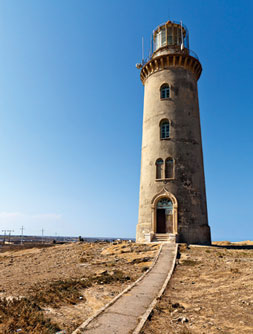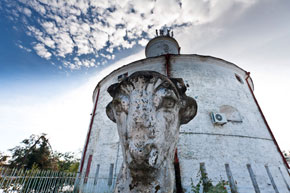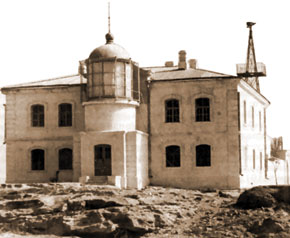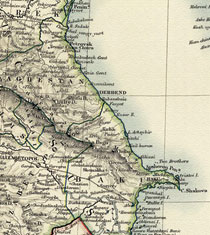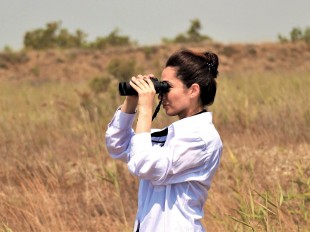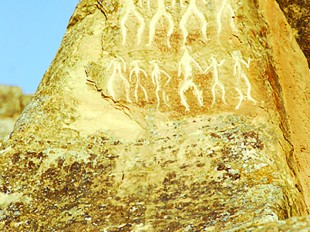Russia began a detailed survey of the Caspian Sea coastline in 1854 and was soon producing pilot charts. Captain N.A. Ivashintsev reported to the tsar that:
….the area around the Absheron Peninsula is the most important part of the Caspian Sea in terms of navigation. All ships (both commercial and peacekeepers) sailing between Astrakhan, Transcaucasia and Persian ports pass through this part of the sea. The Absheron Strait serves as a kind of natural halt for these sailors; they wait there for a fair wind and find shelter from the strong N and NW winds, because there is no similar anchorage on the entire western shore from Chechnya Island to Absheron.
Back in 1852, a Caucasus governor had proposed the construction of a lighthouse on the northern shores of Absheron [Azerbaijan’s ‘beak’ projecting into the Caspian Sea – ed.], however the idea was rejected for lack of funding. The question of maritime security rose again several years later when the Cuba, a large exploration steamboat, was wrecked near Shoulan cape on 14 September 1857.
However, despite that accident, exploration continued with renewed energy. Three lighthouses (Absheron, Amburan in Nardaran and Shoulan, which serve to the present day) were constructed from the 1950s on the northern shores of the peninsula to aid navigation.
From beacon to lighthouse
Maiden Tower was one of the first structures to be adapted to serve shipping. A watch light was installed on the tower on 13 June 1858 to help ships entering Baku Bay at night. It was visible for 15 km. During the day the tower could not be distinguished against the background of the surrounding mountains, so in 1895 a broad white strip was applied to its upper part. However, it soon became clear that this did not solve the problem.
Many of our historians believe that Maiden Tower was used as a beacon many centuries before 1858. Scientists say that a flue system for a fire on Maiden Tower could have created a unique effect, with the fire fuelled by a direct source of gas burning at the very top of the tower. However, as happened with Ateshgah, the fire worshippers’ temple in the Surakhany suburb of Baku, gas reservoirs eventually become depleted; it is quite possible that the same happened at Maiden Tower.
Baku’s late nineteenth century oil boom also played a role. The city developed and expanded rapidly, navigation also increased. The world’s first oil tankers, ‘offspring’ of the Nobel Brothers’ company, arrived on the scene. The first tanker, the Zoroaster, was launched in 1878 and within two years Marcus Samuel had inspected the first vessels to transport oil from Baku’s port. This was the same Marcus Samuel who later managed to convince Lloyds of London that the Nobel’s constructions were sound enough. As a result, the very first ocean tanker, loaded with Baku oil, was sent to ports in South Asia via the Suez Canal. But that was all much later. Before that the captains of many vessels struggled with the main problem: in daylight the Maiden Tower lighthouse would fade into the mountain backdrop and at night its flashes would be lost among the numerous lights of a large and growing city.
For the Russian Empire, Baku’s port was also militarily strategic, especially when the great powers of the day, were openly preparing to divide up the Middle East, particularly Iran and Turkey. Back in 1862, the Russian Empire’s Naval Department quite boastfully reported that they had:
made no mistake in choosing Baku as a port in the Caspian Sea: the depth of coastal water, the seabed, firm anchorage, salubrious climate refreshed by constant wind, the proximity of local oil fires providing free illumination – all of these factors are favourable for a naval port, especially as vessels can put to sea all year round, while Astrakhan is iced up for about four months.
Maiden Tower was used as a lighthouse until 1907. But then the problems with its visibility led to its replacement by one on Narghin Island.
Towers over Absheron
In 1859 the Absheron lighthouse was built opposite Pir-Allahi (Holy) Island; it was the largest one locally. An original construction, it was a 25-metre-high stone tower with an arched entrance and anchor-shaped windows. The 102 steps of a spiral staircase led to the top. It began operating on 23 October 1860. Visible from 38 km, it provided vessels with safe entrance to the Absheron strait between the mainland and Pir-Allahi Island at night. The light originally came from a kerosene lamp, which was replaced by a kerosene-incandescent construction in 1912.
Documents in Azerbaijan’s State Historical Archive tell of the daily work of all the old lighthouses along the homeland shores of the Caspian Sea.
From the Central Station N1207 of 3 October 1912 – Absheron – Lighthouse.
You are designated a constant adjustment of the barometer of minus zero four tenths instead of minus zero one. Set a new adjustment. A. Vangenheim.
From 1956 electricity was installed in the Absheron lighthouse and there is now a 500 watt electric lamp and a system of special lenses. Three old-established towers are located nearby.
In 1874 the Baku Society for the Rescue of those in Peril at Sea constructed a rescue station to the north of the entrance to the Absheron strait, on Shoulan cape. 33 years later, in 1907, the society installed on the roof a lamp with an optic structure and visible from 15 km. After reconstruction of the light source in 1935, visibility was increased to 24 km. The operators live in the two-storey building with their families.
The lighthouse on Narghin (Boyuk Zira) Island first operated on 11 December 1884. Constructed on the western reach of Narghin Island, it allowed vessels to safely enter Baku Bay at night. It was a single-storey stone residential building with a three-metre lamp tower on the roof, with a kerosene-wick torch. It was replaced later by a gas lamp with a fourth-category light-optical device, specially produced in Sweden.
Wartime demolition
This lighthouse was blown up by order of the Soviet military at the beginning of the war, in 1941. An air defence unit was being established on the island to protect Baku and the light would have been useful to enemy planes. It was only re-established in 1958. An 18 metre high stone tower with a sophisticated optical navigation system was built on the high ground in the centre of the island; it is still in use and is visible for 20-30 km. The lamp is charged by solar batteries which can function for up to seven days, but there is also a standby diesel generator to supply electricity.
The Amburan (Nardaran) lighthouse was built in 1882 on the Amburan headland. This was a two-storey stone residential building with a lamp on the roof, which was installed in 1884. The light was distinguished that of other Absheron lighthouses by its reddish-white beam. Its original sectoral sweep was replaced by circular coverage following reconstruction in September 1983. There used to be another interesting tower on Kalakha cape, near the Amburan lighthouse.
From Paris to Pig Island
The small Svinoy (pig) /Sangi-Mughan Island is no bigger than 1 km by 1 km. It has scarce vegetation and two craters of mud volcanoes, and is surrounded by shoals. It was included in the Absheron lighthouse system. There was also a meteorological station with a small housing settlement. This lighthouse was famous for being produced in France in 1891 to the calculations and drawings of the engineer behind that most elegant of metal towers, the Eiffel. The lighthouse was a cast-iron pipe approximately 50 metres high. When one of the mud volcanoes erupted, a fountain of gas, more than 150 metres high, melted and damaged the cast-iron part of the pipe. It was later replaced by a modern electronic lighthouse.
The toponym Sangi-Mughan is based on the word sang, which means stone in Persian; Mughan was the name of a region. Other sources offer a different name for the island – Sangi-Muzaffar. In old times, the island was a place of exile and was eventually called Ostrov s vinoy in Russian (Island of Guilt), later the name became Svinoy.
One of the earliest mentions of the western coast of the Caspian Sea appeared in the notes of Prisk Pontic, a Byzantine author of the early 5th century; using stories from the Romans, he described the route from Scythia to Media and mentioned a place where flame puffs from the sea rocks. This evidence, no doubt, refers to the oil and gas fields.
Sangi-Mughan has always been on the most important sea lane to the southern Caspian, as well as to the entrance to the Kur River, and it certainly attracted sailors from many countries. This is described in detail by Arab and other authors, who left much information about sea voyages across the western Caspian in the 9th-11th centuries. Many medieval anchors of various constructions have been found in the island’s waters and the presence of two mud volcanoes on a small island implies nearby deposits of oil and gas. It is quite possible that gas could have burst to the surface and burned as an eternal fire, surely amazing ancient seamen. A fire temple could very well have existed on the island. The volcanic clay of outstanding quality could be used as construction material. It is still widely used today.
In 1747, a lighthouse was being built at the same time as Lenkeran’s fortress and was put to good use in the war of 1826-1828. It was built to French design, standing 30.5 metres high, 33.4 metres including the lamp. It was fully renovated in 1957.
Lights afloat
As well as stationary lighthouses, there were also floating lights: the Middle-Pearl, the floating light on Shah’s Beak, the Spare light and one at Krasnovodsk. There were two lighthouses at the mouth of the Kur River; they have since become redundant. Another is located in Astara, on the border of Azerbaijan and Iran, the subject of another archival document:
Central Hydro-meteorological Station of the Caspian Sea, Petrovsk Dagestan Oblast, 8 October 1912: to the inspector of the hydro-meteorological station in Astara.
In forecasting the weather, light phenomena in the atmosphere are important indicators of atmospheric conditions across large areas of the upper layers. In organising research into these phenomena, the Central Station thus forwards books by Professor V. Vrounov: ‘Weather Forecast According to Light Phenomena in the Atmosphere’ and ‘Celestial Barometer’ and suggests the taking of systematic notes on observations of abnormal refractions, mirages, circles and crowns, the colour of the dawn, form of the sky and other occurrences, according to the books attached.
Because of the interest and value of these observations, the Central Station hopes that you will pay due attention to this matter. Head of Central Station A. Vangenheim.
Apart from the lighthouses already mentioned, the Caspian fleet at various times included at least three floating lights which, according to old maritime tradition, marked dangerous reefs and shoals, where it was impossible to erect a stationary lighthouse with a beacon at the top of the tower. Thus they solved, to some degree, the problems of navigational security in the Caspian Sea.
Author’s note: while preparing the article, materials were used from the collection of the State Historical Archive of Azerbaijan.
….the area around the Absheron Peninsula is the most important part of the Caspian Sea in terms of navigation. All ships (both commercial and peacekeepers) sailing between Astrakhan, Transcaucasia and Persian ports pass through this part of the sea. The Absheron Strait serves as a kind of natural halt for these sailors; they wait there for a fair wind and find shelter from the strong N and NW winds, because there is no similar anchorage on the entire western shore from Chechnya Island to Absheron.
Back in 1852, a Caucasus governor had proposed the construction of a lighthouse on the northern shores of Absheron [Azerbaijan’s ‘beak’ projecting into the Caspian Sea – ed.], however the idea was rejected for lack of funding. The question of maritime security rose again several years later when the Cuba, a large exploration steamboat, was wrecked near Shoulan cape on 14 September 1857.
However, despite that accident, exploration continued with renewed energy. Three lighthouses (Absheron, Amburan in Nardaran and Shoulan, which serve to the present day) were constructed from the 1950s on the northern shores of the peninsula to aid navigation.
From beacon to lighthouse
Maiden Tower was one of the first structures to be adapted to serve shipping. A watch light was installed on the tower on 13 June 1858 to help ships entering Baku Bay at night. It was visible for 15 km. During the day the tower could not be distinguished against the background of the surrounding mountains, so in 1895 a broad white strip was applied to its upper part. However, it soon became clear that this did not solve the problem.
Many of our historians believe that Maiden Tower was used as a beacon many centuries before 1858. Scientists say that a flue system for a fire on Maiden Tower could have created a unique effect, with the fire fuelled by a direct source of gas burning at the very top of the tower. However, as happened with Ateshgah, the fire worshippers’ temple in the Surakhany suburb of Baku, gas reservoirs eventually become depleted; it is quite possible that the same happened at Maiden Tower.
Baku’s late nineteenth century oil boom also played a role. The city developed and expanded rapidly, navigation also increased. The world’s first oil tankers, ‘offspring’ of the Nobel Brothers’ company, arrived on the scene. The first tanker, the Zoroaster, was launched in 1878 and within two years Marcus Samuel had inspected the first vessels to transport oil from Baku’s port. This was the same Marcus Samuel who later managed to convince Lloyds of London that the Nobel’s constructions were sound enough. As a result, the very first ocean tanker, loaded with Baku oil, was sent to ports in South Asia via the Suez Canal. But that was all much later. Before that the captains of many vessels struggled with the main problem: in daylight the Maiden Tower lighthouse would fade into the mountain backdrop and at night its flashes would be lost among the numerous lights of a large and growing city.
For the Russian Empire, Baku’s port was also militarily strategic, especially when the great powers of the day, were openly preparing to divide up the Middle East, particularly Iran and Turkey. Back in 1862, the Russian Empire’s Naval Department quite boastfully reported that they had:
made no mistake in choosing Baku as a port in the Caspian Sea: the depth of coastal water, the seabed, firm anchorage, salubrious climate refreshed by constant wind, the proximity of local oil fires providing free illumination – all of these factors are favourable for a naval port, especially as vessels can put to sea all year round, while Astrakhan is iced up for about four months.
Maiden Tower was used as a lighthouse until 1907. But then the problems with its visibility led to its replacement by one on Narghin Island.
Towers over Absheron
In 1859 the Absheron lighthouse was built opposite Pir-Allahi (Holy) Island; it was the largest one locally. An original construction, it was a 25-metre-high stone tower with an arched entrance and anchor-shaped windows. The 102 steps of a spiral staircase led to the top. It began operating on 23 October 1860. Visible from 38 km, it provided vessels with safe entrance to the Absheron strait between the mainland and Pir-Allahi Island at night. The light originally came from a kerosene lamp, which was replaced by a kerosene-incandescent construction in 1912.
Documents in Azerbaijan’s State Historical Archive tell of the daily work of all the old lighthouses along the homeland shores of the Caspian Sea.
From the Central Station N1207 of 3 October 1912 – Absheron – Lighthouse.
You are designated a constant adjustment of the barometer of minus zero four tenths instead of minus zero one. Set a new adjustment. A. Vangenheim.
From 1956 electricity was installed in the Absheron lighthouse and there is now a 500 watt electric lamp and a system of special lenses. Three old-established towers are located nearby.
In 1874 the Baku Society for the Rescue of those in Peril at Sea constructed a rescue station to the north of the entrance to the Absheron strait, on Shoulan cape. 33 years later, in 1907, the society installed on the roof a lamp with an optic structure and visible from 15 km. After reconstruction of the light source in 1935, visibility was increased to 24 km. The operators live in the two-storey building with their families.
The lighthouse on Narghin (Boyuk Zira) Island first operated on 11 December 1884. Constructed on the western reach of Narghin Island, it allowed vessels to safely enter Baku Bay at night. It was a single-storey stone residential building with a three-metre lamp tower on the roof, with a kerosene-wick torch. It was replaced later by a gas lamp with a fourth-category light-optical device, specially produced in Sweden.
Wartime demolition
This lighthouse was blown up by order of the Soviet military at the beginning of the war, in 1941. An air defence unit was being established on the island to protect Baku and the light would have been useful to enemy planes. It was only re-established in 1958. An 18 metre high stone tower with a sophisticated optical navigation system was built on the high ground in the centre of the island; it is still in use and is visible for 20-30 km. The lamp is charged by solar batteries which can function for up to seven days, but there is also a standby diesel generator to supply electricity.
The Amburan (Nardaran) lighthouse was built in 1882 on the Amburan headland. This was a two-storey stone residential building with a lamp on the roof, which was installed in 1884. The light was distinguished that of other Absheron lighthouses by its reddish-white beam. Its original sectoral sweep was replaced by circular coverage following reconstruction in September 1983. There used to be another interesting tower on Kalakha cape, near the Amburan lighthouse.
From Paris to Pig Island
The small Svinoy (pig) /Sangi-Mughan Island is no bigger than 1 km by 1 km. It has scarce vegetation and two craters of mud volcanoes, and is surrounded by shoals. It was included in the Absheron lighthouse system. There was also a meteorological station with a small housing settlement. This lighthouse was famous for being produced in France in 1891 to the calculations and drawings of the engineer behind that most elegant of metal towers, the Eiffel. The lighthouse was a cast-iron pipe approximately 50 metres high. When one of the mud volcanoes erupted, a fountain of gas, more than 150 metres high, melted and damaged the cast-iron part of the pipe. It was later replaced by a modern electronic lighthouse.
The toponym Sangi-Mughan is based on the word sang, which means stone in Persian; Mughan was the name of a region. Other sources offer a different name for the island – Sangi-Muzaffar. In old times, the island was a place of exile and was eventually called Ostrov s vinoy in Russian (Island of Guilt), later the name became Svinoy.
One of the earliest mentions of the western coast of the Caspian Sea appeared in the notes of Prisk Pontic, a Byzantine author of the early 5th century; using stories from the Romans, he described the route from Scythia to Media and mentioned a place where flame puffs from the sea rocks. This evidence, no doubt, refers to the oil and gas fields.
Sangi-Mughan has always been on the most important sea lane to the southern Caspian, as well as to the entrance to the Kur River, and it certainly attracted sailors from many countries. This is described in detail by Arab and other authors, who left much information about sea voyages across the western Caspian in the 9th-11th centuries. Many medieval anchors of various constructions have been found in the island’s waters and the presence of two mud volcanoes on a small island implies nearby deposits of oil and gas. It is quite possible that gas could have burst to the surface and burned as an eternal fire, surely amazing ancient seamen. A fire temple could very well have existed on the island. The volcanic clay of outstanding quality could be used as construction material. It is still widely used today.
In 1747, a lighthouse was being built at the same time as Lenkeran’s fortress and was put to good use in the war of 1826-1828. It was built to French design, standing 30.5 metres high, 33.4 metres including the lamp. It was fully renovated in 1957.
Lights afloat
As well as stationary lighthouses, there were also floating lights: the Middle-Pearl, the floating light on Shah’s Beak, the Spare light and one at Krasnovodsk. There were two lighthouses at the mouth of the Kur River; they have since become redundant. Another is located in Astara, on the border of Azerbaijan and Iran, the subject of another archival document:
Central Hydro-meteorological Station of the Caspian Sea, Petrovsk Dagestan Oblast, 8 October 1912: to the inspector of the hydro-meteorological station in Astara.
In forecasting the weather, light phenomena in the atmosphere are important indicators of atmospheric conditions across large areas of the upper layers. In organising research into these phenomena, the Central Station thus forwards books by Professor V. Vrounov: ‘Weather Forecast According to Light Phenomena in the Atmosphere’ and ‘Celestial Barometer’ and suggests the taking of systematic notes on observations of abnormal refractions, mirages, circles and crowns, the colour of the dawn, form of the sky and other occurrences, according to the books attached.
Because of the interest and value of these observations, the Central Station hopes that you will pay due attention to this matter. Head of Central Station A. Vangenheim.
Apart from the lighthouses already mentioned, the Caspian fleet at various times included at least three floating lights which, according to old maritime tradition, marked dangerous reefs and shoals, where it was impossible to erect a stationary lighthouse with a beacon at the top of the tower. Thus they solved, to some degree, the problems of navigational security in the Caspian Sea.
Author’s note: while preparing the article, materials were used from the collection of the State Historical Archive of Azerbaijan.
